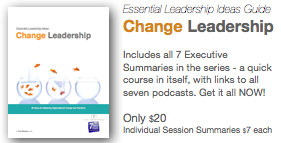Master Change Leadership
18/01/10 Filed in: Leadership Articles | 7IC Change
Essential Competencies for Shaping Your Organization’s Future

Change touches the essential core of leadership. Nothing tests leadership acumen like surviving and thriving the waves of change while shaping your organization’s future.
The everyday work that people do consists of structured activity designed to accomplish the goals of the organization. Those in charge must manage well for performance, i.e. they must align resources (including people) within established processes to achieve predetermined objectives. This is critical. People need structure and processes to perform. Managing provides essential stability.
Especially in today’s world, the underlying structures and processes that shape performance do not last long because of innovation and competition. Whatever your organization does today, you can bet it will need to be tweaked or transformed tomorrow - in ways that can be difficult to foresee.
Leading is the act of gaining willing followers for a course of action when the path forward is unclear or undetermined. The act of leading begins when people choose to follow someone on a course of action. The driving objective of leading is change - movement from one state or condition to another.
Effective organizations always have a creative tension between leading and managing. Remove change and uncertainty from the picture, and simply managing would be sufficient. When changes are asked of employees, customers, and stakeholders, the heightened uncertainty and corresponding hunger for stability cause this creative tension to be accentuated. Good managing is critical, but to make effective changes, good leading is vital.
Do you need people to work well beyond minimum effort? Do you want them to stick with changes once they are implemented? Do you need people that embrace innovation, and are ready for the next change when it comes down the road?
Then crank up your skill in change leadership! Here are seven essential actions where you will want to focus your efforts. Each action is further explored in a corresponding 7 Ideas Coach audio podcast (available on the web at www.ThinkLeadershipIdeas.com and from Apple iTunes. The e-book Change Leadership: 49 Ideas for Mastering Organizational Change and Transition includes the podcasts, a 7-point executive summary of each action, and links to related articles.)
Leading change is a core leadership competency that executives, managers, business owners, community leaders, and knowledge professionals must develop to excel in the 21st century. The challenges of change are great, but greater still are the rewards for leading change artfully. ◀
Seven actions to foster mastery of leading change...
Understand the Real Challenges
Conventional wisdom is that people inherently resist change, that any organizational change is difficult. This assumption can get in the way of effective change leadership. It’s worth thinking a little deeper. Leaders who understand the nuances of change, who recognize the difference between change and transition, and who can access a range of leadership styles will be better prepared to address real challenges of change.
Manage Transitions
Change happens quickly, but transition take time. Effective change leaders understand they lead change and manage transition. The latter requires high levels of communication, sensitivity to emotional “states” of transition, and attention to the human process of incorporating change into experience.
Lead Change That Sticks
How change is introduced will make a profound difference in the likelihood of people drifting back into old ways of doing business. Bold and quick action, persistence, identification and support of champions, and attention to framing how people think about change contribute to making change stick.
Gain Willing Followers
A fundamental paradox of effective leadership is that people make their best effort only when they voluntarily choose to do so. Leading is the art of giving people a genuine choice to follow, while making the choice to follow irresistibly compelling.
Win Buy-In
Leaders cannot afford to ignore creating buy-in for expected change, and need to do so across a wide section of stakeholders.
Handle Complexity Wisely
The combination of knowledge-based work plus increased complexity impact what kind of leadership styles are most effective and what kind of leaders are needed for the future. Low complexity calls for directive leadership, whereas high complexity makes best use of facilitative leadership skills.
Cultivate a Change Culture
Culture is what people do when the boss isn’t looking. Wise leaders give attention to cultivating a culture where people naturally embrace and seek innovation that adds value.

Change touches the essential core of leadership. Nothing tests leadership acumen like surviving and thriving the waves of change while shaping your organization’s future.
The everyday work that people do consists of structured activity designed to accomplish the goals of the organization. Those in charge must manage well for performance, i.e. they must align resources (including people) within established processes to achieve predetermined objectives. This is critical. People need structure and processes to perform. Managing provides essential stability.
Especially in today’s world, the underlying structures and processes that shape performance do not last long because of innovation and competition. Whatever your organization does today, you can bet it will need to be tweaked or transformed tomorrow - in ways that can be difficult to foresee.
Leading is the act of gaining willing followers for a course of action when the path forward is unclear or undetermined. The act of leading begins when people choose to follow someone on a course of action. The driving objective of leading is change - movement from one state or condition to another.
Effective organizations always have a creative tension between leading and managing. Remove change and uncertainty from the picture, and simply managing would be sufficient. When changes are asked of employees, customers, and stakeholders, the heightened uncertainty and corresponding hunger for stability cause this creative tension to be accentuated. Good managing is critical, but to make effective changes, good leading is vital.
Do you need people to work well beyond minimum effort? Do you want them to stick with changes once they are implemented? Do you need people that embrace innovation, and are ready for the next change when it comes down the road?
Then crank up your skill in change leadership! Here are seven essential actions where you will want to focus your efforts. Each action is further explored in a corresponding 7 Ideas Coach audio podcast (available on the web at www.ThinkLeadershipIdeas.com and from Apple iTunes. The e-book Change Leadership: 49 Ideas for Mastering Organizational Change and Transition includes the podcasts, a 7-point executive summary of each action, and links to related articles.)
Leading change is a core leadership competency that executives, managers, business owners, community leaders, and knowledge professionals must develop to excel in the 21st century. The challenges of change are great, but greater still are the rewards for leading change artfully. ◀
Seven actions to foster mastery of leading change...
Understand the Real Challenges
Conventional wisdom is that people inherently resist change, that any organizational change is difficult. This assumption can get in the way of effective change leadership. It’s worth thinking a little deeper. Leaders who understand the nuances of change, who recognize the difference between change and transition, and who can access a range of leadership styles will be better prepared to address real challenges of change.
Manage Transitions
Change happens quickly, but transition take time. Effective change leaders understand they lead change and manage transition. The latter requires high levels of communication, sensitivity to emotional “states” of transition, and attention to the human process of incorporating change into experience.
Lead Change That Sticks
How change is introduced will make a profound difference in the likelihood of people drifting back into old ways of doing business. Bold and quick action, persistence, identification and support of champions, and attention to framing how people think about change contribute to making change stick.
Gain Willing Followers
A fundamental paradox of effective leadership is that people make their best effort only when they voluntarily choose to do so. Leading is the art of giving people a genuine choice to follow, while making the choice to follow irresistibly compelling.
Win Buy-In
Leaders cannot afford to ignore creating buy-in for expected change, and need to do so across a wide section of stakeholders.
Handle Complexity Wisely
The combination of knowledge-based work plus increased complexity impact what kind of leadership styles are most effective and what kind of leaders are needed for the future. Low complexity calls for directive leadership, whereas high complexity makes best use of facilitative leadership skills.
Cultivate a Change Culture
Culture is what people do when the boss isn’t looking. Wise leaders give attention to cultivating a culture where people naturally embrace and seek innovation that adds value.
***
by Tom Stevens (c)2010
Tom Stevens helps leaders create and sustain exceptional organizations. To contact him, visit www.ThinkLeadershipIdeas.com
This article may be freely reprinted in your company, association, or publication (or website) under the following terms: that the author attribution, copyright notice, contact information, and this reprint notice be included; and that you inform us that you are using the article (samples appreciated).
Want it written out for you?
Want all the ideas in this series at your fingertips?
Want in NOW? Available for instant download.... more info

blog comments powered by Disqus
